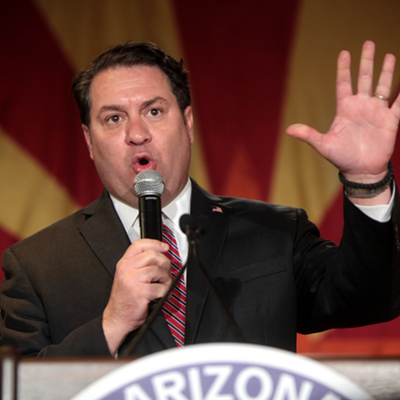BLACK AND BLUES
Acclaimed author and Fox Television/NPR talking head Juan Williams (Eyes on the Prize) addressed the Tucson YWCA's "It's Time to Talk" forum last week at the Doubletree Hotel and told his high-minded audience that "this is a critical moment in racial justice," according to coverage in the Arizona Daily Star.The irony of his appearance, on the day that lawyers in the Tyrone Johnson trial delivered closing arguments that the Star did not cover, was too great to miss.
Too bad Williams and his listeners didn't board a bus for the Evo DeConcini Federal Courthouse downtown, where they would have heard two white lawyers for two Tucson cops, four Tucson firefighter paramedics and EMTs, and two Southwest Ambulance EMTs--all but one of the eight white--savage the late Tyrone Johnson, the son of an African-American father and white mother.
While Williams faulted television and shows like Seinfeld and Friends (startling!) for utterly failing to recognize social problems, he and his listeners could have seen some in Tucson. In the fifth-floor courtroom of Judge John M. Roll, they would have seen and felt a racial gulf wide enough to make you wonder where the drinking fountains labeled "colored" were.
Johnson's family--which brought the suit as a result of Tyrone's death after being beaten and pepper sprayed by police following a brief chase on Aug. 8, 1999--even had to be careful where they parked outside the courthouse. Timothy Johnson, Tyrone's older brother, committed the grave mistake of parking one day, next to the SUV of Karen Audilett, who assisted her husband, Daryl Audilett, the attorney for the police and firefighters. She complained that she was being "threatened," and marshals began to appear.
Johnson, a former prep football star, was under suspicion for extended periods of time for all sorts of alleged wrongdoing. Tucson policeman Ray Thompson, who stands 6-foot-7, watched Tyrone and his Pueblo Gardens home for up to several hours a day for nearly half a year. He found nothing.
Three weeks after Thompson stopped parking on Johnson's block, he was at the Circle K at South Craycroft and East Golf Links roads where he, according to a 911 call, saw Tyrone pumping gas into a Cadillac. Thompson, according to a tape replayed in court, said gas was leaking out of the Cadillac's tank.
"It doesn't look like (Circle K clerks) are going to do anything about it," said Thompson, off duty and eating a burrito while he was "supposed to go play golf."
Thompson added that the man pumping the gas was "one of my bad guys."
Audilett told jurors to ask themselves why Thompson was not a defendant, since he could be seen to have had a role in instigating the chain of events that led to Johnson's death. But Thompson was indeed a defendant--until Roll granted a motion last year to dismiss him and other city defendants.
Roll would not allow the Johnson family lawyer Stanton Bloom to explain that to jurors, a move on par with Roll's apparent inclination to keep Bloom in a straightjacket. This is not particularly unusual for a career prosecutor-turned-judge who has never represented a client and who has made it difficult, in several cases, for African Americans to bring lawsuits. Roll was put on the federal bench by Bush the first. Roll was pleasant, clear and courteous with everyone--except Bloom, in whose direction Roll launched several flashes of anger in front of the jury.
Roll moved to the federal bench from the Arizona Court of Appeals. Gov. Evan Mecham, a Republican who was recalled in his second year, appointed Roll to the state bench early in his term in 1987, shortly after Mecham cancelled the state's Martin Luther King holiday and defended the use of the term "pickaninny" to describe African-American children.
VIÑOLY VICTORIOUS
Word is that Rafael Viñoly, a big-time New York architect with projects in locations as far-flung as Beijing and Buenos Aires, has won the commission to design the UA Science Center, the centerpiece of Rio Nuevo.Viñoly, who got much ink recently for his handsome Kimmel Performing Arts Center in Philadelphia, joined forces with Tucson architect Jim Gresham. Their team beat out four other firms on the short list, including Tucson's own architectural star, Rick Joy, and Phoenix's Wil Bruder. Viñoly/Gresham ranked first, and pending negotiation of a contract, will be announced as the winning architects at the end of May.
With a price tag of $72.7 million ($100 million when you count the value of the exhibits the UA will transfer to the museum, and so on), the museum is the largest of the Rio Nuevo projects meant to revitalize downtown. The Science Center is actually a UA deal, with Rio Nuevo contributing only about $20 million. It will replace the much-smaller Flandrau Museum and Science Center on the UA campus, while offering a state-of-the-art planetarium, an observatory, a large-screen theatre and an Arizona-Sonora Desert Museum display. Built on either side of the Santa Cruz riverbed, it will feature an enclosed, river-spanning bridge laden with exhibits. The bridge is meant to lure visitors from Rio Nuevo's east side, behind the Tucson Convention Center, to the west side, where the historical attractions, including a re-created Convento, will lie.
Viñoly, a native of Uruguay born in 1944, first made a splash in Argentina in the 1970s, making what one Tucson architect calls "dynamite stuff." Fleeing the oppressive political regime in 1978, Viñoly re-established himself in New York. His web site ( rvcpa.com ) lists more than 200 high-profile projects, including the Tokyo International Forum, a cultural center built in 1996 after an international competition, an upcoming addition to the John F. Kennedy Center for the Performing Arts in Washington, D.C., and a new Boston Convention Center to open this June. His museum projects include renovations at the American Museum of Natural History, the Brooklyn Children's Museum and the Cleveland Museum of Art.
MATTER OVER MIND
Money woes have forced CODAC Behavioral Health Services--one of three local outfits that provide help to low-income Pima County residents who suffer from a range of mental problems--to dismiss 23 employees, including 12 case managers.W. Mark Clark, CEO of CODAC, says the workers were let go because the organization is trying out a new treatment model, though he adds that a tight budget is part of the problem.
"If we had all the money there was to have in the world, we wouldn't have laid off people," says Clark.
In this case, releasing the case managers with advanced degrees saves money. CODAC was paying managers with master's degrees around $29,000 a year, while employees with bachelor degrees earn just $25,000.
The new treatment model for CODAC, which serves between 4,500 to 5,000 clients at any one time, will have the unfortunate folks who need help functioning in today's increasingly irrational world--help that ranges from counseling to assistance with finding a job or a place to live--dealing with teams of caseworkers rather than a specific individual caseworker.
But the lay-offs are making a tough job tougher in the short run, according to Clark.
"Anytime you go into an organization and tell people they can't work for you anymore, there's obvious disruption," says Clark, who adds that the layoffs have upset both clients and the remaining 50 or so caseworkers, who will have to pick up extra responsibilities. "Folks are going to have to do more work; that's for sure."
Clark says the behavioral health field is "under some distress" because a change in state law is forcing people who are eligible for AHCCCS to re-enroll in the program every six months, rather than once a year. As a result, the number of people in the system has dropped, which means that fewer funds flow to the Community Partnership of Southern Arizona, the nonprofit organization that oversees local mental-health providers, including CODAC, COPE and La Frontera.
"Thousands of people have fallen off of AHCCCS here in Pima County," says Clark. "There have been more than 2,000 people in the first three months of this year who were enrolled in the behavioral health system who lost their AHCCCS eligibility."
Because behavioral health clients often have serious mental illness, it's not always easy for them to fill out the proper paperwork in triplicate, says Clark.
On top of that, the state Department of Economic Security didn't get an additional staff to handle the new paperwork.
"They are months behind on that," Clark says.
So, what happens? People don't think they have benefits anymore; they stop seeing their doctors and getting their meds; and then they have some kind of episode and end up in the hospital, which carries even higher costs for taxpayers.
The squeeze at CODAC is not unique. Earlier this year, COPE laid off about 45 of their 400 workers, according the COPE executive director Pat Benchik. He says the workers were on the administrative side and did not affect patient care.
Neal Cash, CEO of the Community Partnership of Southern Arizona, says local mental-health agencies are being forced to "use limited resources as effectively as possible."
"It's not just the behavioral health agencies," says Cash. "We could talk about health care, we could talk about education, we could talk about corporate America. You're always looking at how you can retool and best utilize what you have."
BILLBOARD BULLETIN
The topic of billboards is back on the Pima County Board of Supervisors' agenda next Tuesday, May 11, when the board will receive a report updating them on neighborhood objections to a proposed legal settlement over controversial county billboards.County Administrator Chuck Huckelberry has proposed approving a deal with Clear Channel to eliminate some 38 billboards while allowing another 44 to come into compliance with county codes.
"It's a no-win battle for a local government if we spend a ton of money on litigation and have nothing to show for it at the end the day," Huckelberry says. "On top of that, if we happen to win a case or two, then what typically happens is the Legislature changes the rules, and you can't win anymore.
But anti-billboard crusader Mark Mayer says the deal only dumps a few billboards in lousy locations and allows too many others to remain standing.
"It's a sweetheart settlement," says Mayer.
Neither Huckelberry or Mayer expects the board to take action next week.
















